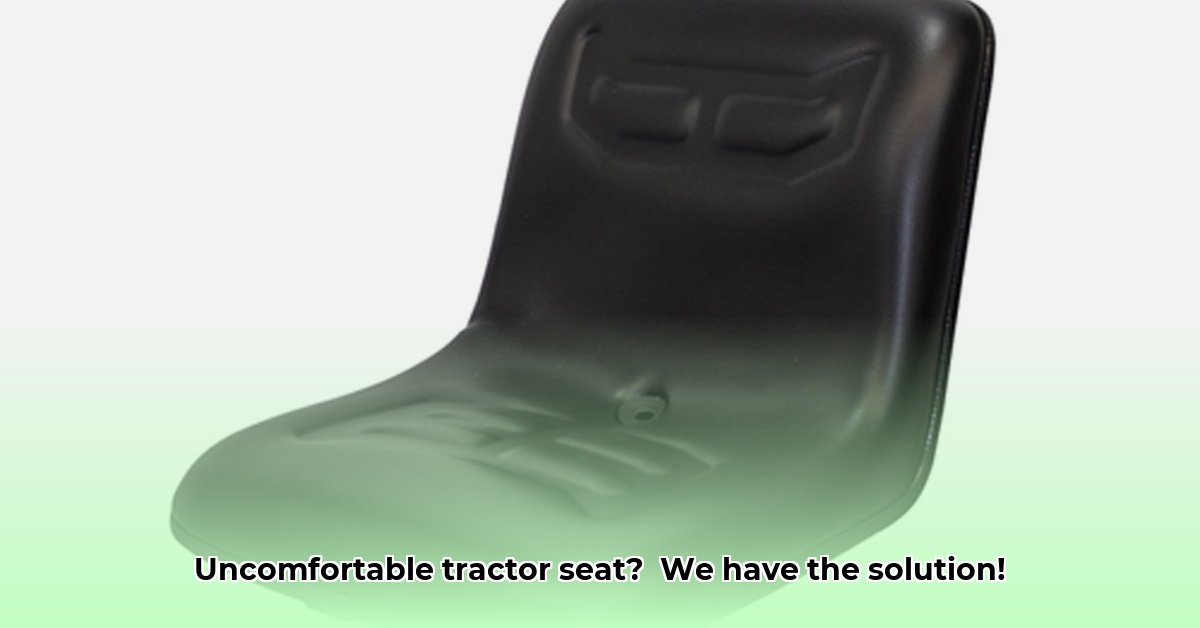
Spending hours operating a New Holland tractor demands a comfortable and supportive seat. A worn or uncomfortable seat not only impacts your comfort but also reduces productivity and increases the risk of injury. This comprehensive guide helps you select, install, and maintain a replacement seat that prioritizes both comfort and safety. For even more in-depth information, check out this helpful resource.
Understanding the Need for Seat Replacement
Backaches, fatigue, and decreased efficiency are common consequences of prolonged use of an uncomfortable tractor seat. These aren't simply inconveniences; they significantly affect your overall health and productivity. While original equipment manufacturer (OEM) seats provide basic functionality, they often lack the adjustability and comfort features found in modern aftermarket seats. Upgrading offers a substantial return on investment in improved operator well-being and increased operational efficiency. Don't underestimate the impact of a comfortable seat on your daily work life. Isn't a healthier, more productive workday worth the upgrade?
Choosing the Right Replacement Seat: A Buyer's Guide
Selecting the perfect replacement seat requires careful consideration of several crucial factors, ensuring compatibility, optimal features, and a reasonable budget.
Compatibility: Ensuring a Perfect Fit
Before focusing on features, compatibility is paramount. Accurate matching with your specific New Holland tractor model is essential for functionality and safety. Precise alignment of mounting holes is critical for a secure installation. Furthermore, ensure your new seat's safety switches are compatible with your tractor's safety system. This is vital for safe operation and to avoid potentially dangerous malfunctions. Incompatibility here can lead to serious safety issues and invalidates any warranty coverage.
Key Features: Comfort, Durability, and Performance
Numerous features influence your comfort and the seat's longevity. Let's delve into the critical aspects.
Suspension Systems: Suspension systems significantly reduce the impact of vibrations and shocks, thereby reducing strain and fatigue over long workdays. Hydraulic, pneumatic (air-filled), and mechanical systems offer various levels of comfort and price points. Consider your typical terrain; rougher conditions benefit from more robust suspension.
Adjustability: A highly adjustable seat allows personalized customization. Adjustable height, lumbar support (crucial for back health), and tilt are key features. Optimizing the seat to your individual body shape and preferences is paramount for sustained comfort and reduced fatigue. This is an investment in your long-term comfort and health.
Materials: Seat material significantly impacts durability and cleanability. Vinyl is cost-effective and relatively easy to clean. Fabric offers breathability, while leather provides superior durability and a premium feel, albeit at a higher price. Think about the practicality of cleaning and your expected lifespan.
Reputable Manufacturers: The absence of standardized testing for tractor seats makes reputable manufacturers crucial. Choose manufacturers with a proven track record, positive customer reviews, and readily available support. Reading online reviews is an invaluable tool.
Budgeting for Your New Seat
Replacement seats range significantly in price, reflecting variations in features and materials. While higher-priced seats often offer superior features, carefully assess your needs and budget. Prioritize features directly impacting comfort and safety, finding a balance between cost and long-term value. Don't forget to factor in the potential for increased productivity as a result of improved comfort.
Warranty and Support: Protecting Your Investment
A comprehensive warranty indicates the manufacturer's confidence in their product's quality. Choose a manufacturer with a robust warranty and a reputation for responsive customer support. A readily available support system mitigates potential problems. Checking warranty details and customer reviews before purchasing is a crucial step.
Installing Your New New Holland Tractor Seat: A Step-by-Step Guide
Installation procedures vary slightly depending on models but generally follow these steps. Always consult the manufacturer's instructions included with your seat. If you are uncomfortable performing this task, consult a qualified mechanic to avoid injury.
Safety First: Disconnect the tractor's battery to prevent accidental starting. Safety should always be your top priority.
Removing the Old Seat: Carefully remove the old seat, noting the connection points for future reference. Photograph the process for easier reassembly.
Preparing the Mounting Area: Thoroughly clean the mounting area to ensure a secure and stable fit.
Installing the New Seat: Align the new seat with the mounting points and fasten securely using the provided hardware.
Reconnecting Components: Reconnect any safety switches or electrical components. Double-check all connections.
Testing and Verification: Thoroughly test the seat's functionality and adjustability before reconnecting the battery.
Reconnect the Battery: Only reconnect the battery after all checks are complete.
Maintaining Your New Seat: Extending its Life
Regular cleaning, periodic inspection for wear and tear, and protection from the elements will extend your seat’s lifespan. Regular maintenance safeguards your investment.
Resources and Further Reading
Refer to the manufacturer's website for detailed instructions and troubleshooting. Online forums and agricultural publications offer additional insights and user experiences. Continuous learning is beneficial to optimize comfort and safety.
Key Takeaways
- Upgrading your New Holland tractor seat significantly enhances operator comfort and safety.
- Compatibility, features, budget, and warranty are crucial factors in choosing a replacement.
- Proper installation is essential for safety and optimal performance.
- Regular maintenance significantly extends the seat's lifespan.